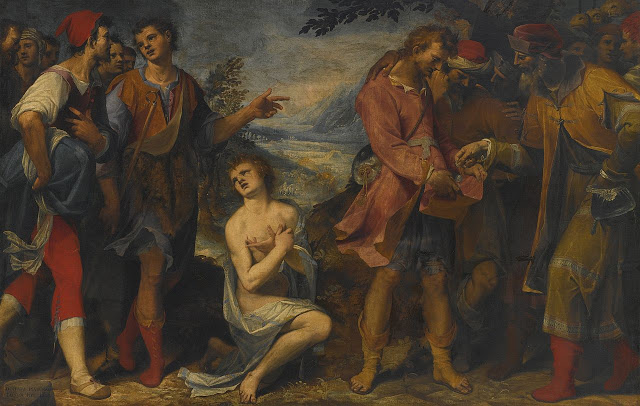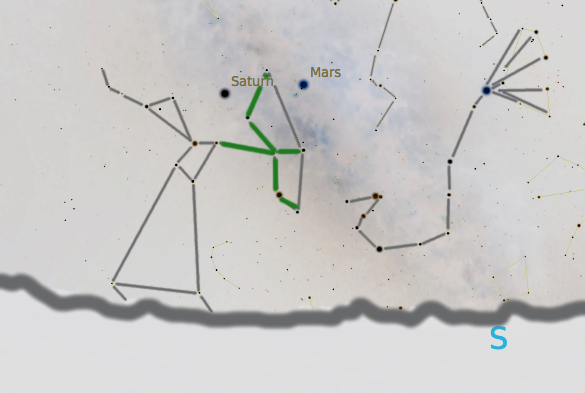image: Wikimedia commons (link).
March 17 is traditionally the day ascribed to the legendary Saint Patrick, associated with the country of Ireland (where, according to the story, Patrick was taken by pirates as a child), and with driving all the snakes out of that island (as seen in many depictions of Saint Patrick, including that found on the greeting card from 1909, shown above).
However, as I explain in a video I posted last July, entitled "The Twelve Disciples of the Zodiac: Philip," there are very good reasons to conclude that -- even if a man named Patrick actually existed as an historical figure -- the story of his chasing the snakes out of Ireland, as well as much of the iconography associated with the figure of Saint Patrick (including his distinctive hand mudra which is seen in the iconography shown here, as well as his association with the three-lobed shamrock) are based on celestial associations which have nothing to do with literal, terrestrial history.
In fact, the very association of Saint Patrick with the point on the earth's orbit which we reach at this time of year, March 17, is almost certainly due to the association of this legendary saint with the constellation Sagittarius. If you make a habit of rising very early in the morning and looking at the glorious stars visible in the sky before the dawn each day, then you are probably already aware that the dazzling constellation of the Scorpion has been rising further and further above the eastern horizon in the pre-dawn sky for the past couple of months (preceded at this particular arrangement of the solar system planets by the planet Jupiter).
Now, as we progress further towards the springtime in the northern hemisphere, the zodiac constellation of Sagittarius, which follows Scorpio in the sky, is becoming fully visible above the horizon in the pre-dawn hours:
Above is a star-chart showing the pre-dawn sky on March 17 from the point-of-view of an observer in the northern hemisphere at about latitude 35 north, looking towards the south such that east is to the left and west is to the right (so that the stars are rising from the left side of the image as we face it, and crossing the sky from left to right, where they will sink down into the western horizon). The color-scheme has been inverted for greater ease of visibility on a screen, and the outlines of some of the major constellations have been drawn in, using the essential constellation-outlining system published by author H. A. Rey in 1952.
Can you see the outline of the constellation Sagittarius, the Archer, clearing the horizon (which has been drawn-in using a heavy wiggly line for ease of identification)? The form of Sagittarius as envisioned in Rey's system includes a rather long "skirt" or dress-like garment, a large bow which points towards the center of the Milky Way Galaxy and to the sinuous form of the Scorpion just beyond the Galactic Core from Sagittarius, and a triangular head with a line rising up from it which can be envisioned as a "plume" or "feather," created by three stars rising in a bent line just above one corner of the constellation's head.
As I explain in the video linked above, my research supported by overwhelming evidence strongly suggests that all of the world's ancient myths, scriptures, and sacred traditions employ a system of celestial metaphor in which specific characters and episodes can be shown to correspond to specific constellations in the heavens above, informed by the distinctive characteristics of those constellations. This common, world-wide system can be shown to form the basis for the stories in the Bible (in both the so-called "Old" and "New" Testaments), as well as the stories in the myths of virtually every culture on our planet.
The constellation Sagittarius appears in some of those ancient stories as a child who is kidnapped and sold into slavery, as in the story of Joseph in the text of the scroll of Genesis, as well as in the story of Saint Patrick of Ireland. As I demonstrate in my 2016 book Star Myths of the World Volume Three (Star Myths of the Bible), this is because the stars in the "bow" of Sagittarius can be envisioned as the hands of the figure of the constellation, crossed and bound, rather than as a bow.
See for example the artwork below of Joseph sold into slavery by his brothers, by Damiano Mascagni from 1602, in which Joseph is depicted with many of the distinctive characteristics of the constellation Sagittarius (including crossed hands and a head turned to "look back" over the shoulder), and in which some of the other characters in the scene are clearly depicted with postures or hand mudras indicating other zodiac constellations, including the goat-horns of Capricorn in the hand just above Joseph's head, or the two hands holding the shirt-front or skirt-front between them (to receive coins from the purchase price) which are indicative of the two Fishes of Pisces with the Great Square of Pegasus in between them:
image: Wikimedia commons (link).
Many other examples could also be offered.
Turning again to the stars themselves, we can easily see how a figure associated with the constellation Sagittarius could be found in a story which involves driving out snakes, because the outline of Scorpio is often envisioned in myth as a serpent with multiple heads, or as a many-headed dragon of some sort (as well as playing the role of the "generation of vipers" referred to by Jesus in the New Testament gospel accounts, as discussed in a post about John the Baptist from 2014, here).
As the earth rotates on its axis towards the east, the stars we see appear to rotate towards the west, which is why Scorpio (located to the west of Sagittarius) appears to be "driven out" by Sagittarius as the earth turns throughout each night -- and why Scorpio will eventually sink out of sight into the western horizon before Sagittarius follows later on.
In the star-chart below, which is identical to the one presented earlier, the figures of Sagittarius and Scorpio have been highlighted and labeled for ease of identification with the story of Saint Patrick:
Note that in the traditional iconography, Saint Patrick is typically depicted wearing a very long robe or cassock. I would even argue that the three-lobed shamrock associated with Saint Patrick may have a celestial correspondence to the bow of the constellation in the sky. Note that the bow is formed in the sky by three "prongs" which branch off of the outstretched arm of the constellation: one in the middle, one going upwards, and one going downwards. These may suggest that the constellation is holding a three-leaf shamrock:
The hand-gesture or "mudra" associated with Saint Patrick is also the same hand-gesture associated with Sagittarius-figures in other stories and myths, as I show in the video from last year. I believe that this particular Sagittarius-mudra comes from the stars which form the distinctive "plume" or "feather" which is visible protruding above the head of the constellation in the sky. You can see the same distinctive hand gesture in other depictions of Saint Patrick, such as those shown below:
images: Wikimedia commons. Left image link and right image link.
Lest anyone object that the outlining-system published by H. A. Rey in 1952 cannot possibly be used in order to analyze celestial connections in ancient myth, it should be pointed out that I have discovered countless examples in ancient art and in the ancient myths themselves which indicate that this ancient world-wide system used a system of envisioning the constellations which corresponds closely to that published by H. A. Rey, whether H. A. Rey was privy to some inherited knowledge passed down through the millennia or not (he himself never discussed this connection to the ancient myths and ancient artwork, to my knowledge).
For example, in the artwork on the bell-krater from the early fifth century BC which constitutes the "name vase" of an artist from ancient Greece known to scholars as the "Pan Painter," the goddess Artemis is depicted slaying the unfortunate youth Actaeon, in outlines which clearly indicate that the ancients were using a very similar way of envisioning the constellation Sagittarius as the method shown in H. A. Rey's books:
Other myths from around the world which involve the figure of Sagittarius chasing away a monster associated with the figure of Scorpio include the god Apollo (the twin of the goddess Artemis) defeating the great dragon or serpent Python.
While literal interpretations of the ancient myths (particularly those contained in the texts we call "the Bible") have been used for centuries to divide humanity (and to excuse the forcible "conversion" of countless cultures to the acceptance of literalistic interpretations of the Bible, as well as the destruction of their own inherited sacred traditions), the overwhelming evidence shows that all the world's ancient myths, scriptures and sacred stories are built upon a common system of celestial metaphor. This fact should actually unite us, rather than dividing us -- and should instantly controvert any arguments of exceptionalism which are used to try to support or excuse such acts of imperialism, colonialism, and conquest.
I hope that on this March 17, 2018, you will have the opportunity to go out and marvel at the glorious constellations in the infinite night sky, if it is at all possible for you to do so. And, if you can, you may want to try rising early to enjoy the dazzling constellations now visible in the pre-dawn sky, and contemplate the cycles which are now bringing Sagittarius that eternal Archer into view, following the enormous figure of Scorpio, in accord with the endless rhythm of the universe.







